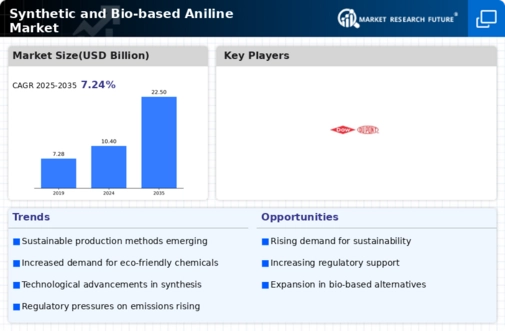Market Analysis
In-depth Analysis of Synthetic Bio-Based Aniline Market Industry Landscape
The market dynamics of synthetic and bio-based aniline are influenced by a combination of factors, reflecting the evolving landscape of the chemical industry. Synthetic aniline, traditionally derived from petrochemical sources, has been a key player in various industrial applications, including the production of dyes, rubber, pharmaceuticals, and agrochemicals. However, the growing concerns over environmental sustainability and the desire to reduce dependence on fossil fuels have given rise to the emergence of bio-based aniline.
One significant driver in the market dynamics is the increasing demand for eco-friendly alternatives. Bio-based aniline, produced from renewable feedstocks such as biomass and agricultural residues, aligns with the global push towards sustainable practices. This shift is particularly noticeable in industries seeking greener solutions to reduce their carbon footprint. As regulatory pressures intensify to address environmental concerns, businesses are exploring bio-based options to meet compliance requirements and consumer expectations.
Furthermore, advancements in biotechnology and the development of innovative production processes play a pivotal role in shaping the market dynamics. The bio-based aniline sector benefits from ongoing research and technological breakthroughs, contributing to enhanced efficiency, cost-effectiveness, and scalability of production methods. These advancements not only bolster the competitiveness of bio-based aniline but also influence the overall pricing dynamics in comparison to its synthetic counterpart.
Price volatility of raw materials, a perennial challenge in the chemical industry, significantly impacts the market dynamics of both synthetic and bio-based aniline. Fluctuations in the prices of feedstocks, such as benzene for synthetic aniline and biomass for bio-based aniline, can influence the production costs, subsequently affecting the market prices. Producers must navigate this inherent uncertainty and strategically manage their supply chains to maintain competitiveness and profitability.
Geopolitical factors also contribute to the market dynamics, especially in the case of synthetic aniline, where geopolitical tensions and trade policies can influence the availability and pricing of key raw materials. The interconnectedness of global markets requires industry players to remain vigilant and adaptable to geopolitical developments that may impact the sourcing and transportation of raw materials.
Consumer preferences and awareness are increasingly shaping the market dynamics, with a growing emphasis on sustainable and ethically sourced products. As consumers become more environmentally conscious, there is a heightened demand for products manufactured using bio-based aniline. Companies responsive to these shifts are incorporating sustainability into their business strategies, influencing the overall market dynamics and pushing for a more sustainable future.





Leave a Comment